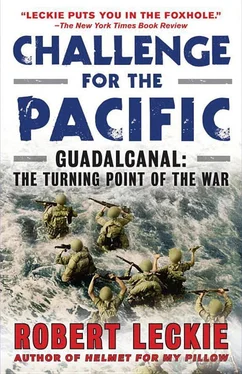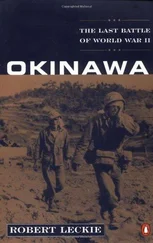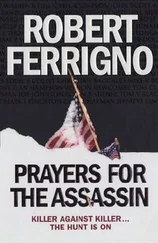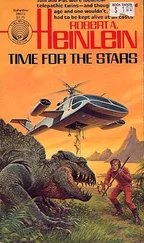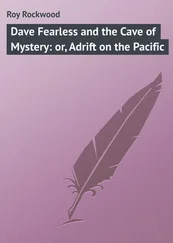Meanwhile, the Marines—unlike other branches of the service—were consistently in action between the wars. They were fighting the “Banana Wars,” learning, in the jungles of Haiti and Nicaragua, all the lessons of jungle warfare that would be applied on a much larger and more vital scale in the wildernesses of Oceania. Service on the Navy’s capital ships taught them to appreciate the importance of seapower, as well as of ship-based air power, and duty at troublesome China stations enabled them to study the Japanese at first hand and to learn—most valuable lesson of all—not to underestimate them.
It was a hard school, but out of it came a stream of tough and seasoned professionals fired with a sense of mission. One of them was Major General Alexander Archer Vandegrift.
Tall, strong, hard-jawed, and extremely courteous, Archer Vandegrift was of old Virginia stock, the grandson of Confederate soldiers. He had spent his boyhood listening to their stories, and he could never forget the grandfather who had prayed to “the God of Abraham, Isaac, Jacob, Robert E. Lee and Stonewall Jackson.” 13Archer Vandegrift was in the mold of Stonewall Jackson. He was both wary and audacious, seldom without a plan. He had been a Marine officer for thirty-three years, having spent some of his most instructive ones under General Smedley D. Butler, the celebrated and legendary “Old Gimlet Eye” of the Banana Wars. Butler had given him the passing nickname of “Sunny Jim” because Vandegrift had ridden the cowcatcher of a rickety old Nicaraguan locomotive, “to look for mines” as Butler had ordered, and had come back to report with a grin on his face.
Two decades later, on March 23, 1942, at New River, North Carolina, General Vandegrift received both his second star and the command of the First Marine Division. He had already been its assistant commander, having helped plan and conduct practice landings, one of which was an oddly prophetical exercise at Solomons Island on Chesapeake Bay. But now he had full charge and he poured all his energies into raising it from about 11,000 men to its full strength of 19,000. Each of the four regiments—First, Fifth, and Seventh rifle regiments, the Eleventh of artillery—was understrength.
From all over the Marine Corps the old salts and China hands came pouring into New River. There were NCOs yanked off soft “planks” at the Navy yards. There were grizzled old gunnery sergeants who had fought in France or chased “Cacos” in Haiti or “bandidos” in Nicaragua. There were inveterate privates who had spent as much time in the brig as in barracks. Gamblers, drinkers and connivers, brawlers who had fought soldiers and sailors of every nationality in every bar from Brooklyn to Bangkok, blasphemous and profane with a fine fluency that would astound an Australian coastwatcher, they were nevertheless professional soldiers who knew their hard calling in every detail from stripping a machine gun blindfolded to tying a tourniquet with their teeth. They were tough and they knew it, and they exulted in that knowledge. No one has described them better than Colonel John W. Thomason: “They were the Leathernecks, the old breed of American regular, regarding the service as home and war as occupation, and they transmitted their temper and character and viewpoint to the high-hearted volunteer mass.”
And those high-hearted volunteers, the new breed, were also streaming into New River, to flesh out the division and to transmit to the old breed something of their own temper: their gaiety and their zest.
These were the youths fresh from boot training at Parris Island. They knew almost nothing about war, but they knew why they had gone to one. In their late teens and early twenties, they had stormed the recruiting centers after the news of Pearl Harbor had been broadcast. Some of them had come straight from basketball games and bowling matches, still clutching the little canvas bags containing their uniforms or bowling balls. They were angry. Their country had been attacked without warning. Standing in line to be examined by the doctors, they had muttered over and over, “The little yellow bastards, the little yellow bastards.” 14They wanted to kill Japs, they told the officers who questioned them. These were not refined or oblique or delicate young men, these youths who were filling the ranks of the First Marine Division that spring; no, they were mostly “tough guys”—some of whom could be fairly described as juvenile delinquents—whose primitive instincts had been aroused by the infamy of the enemy.
Yet, they were idealistic, too. They felt vaguely that they were being noble by volunteering to fight their country’s battles on the very day of disaster. Unfortunately, they had no battle cry to express their inmost feelings. They were not able to shout, like the enemy they would meet, “Blood for the Emperor!” Few of them had heard of the Four Freedoms, and those who had were not likely to proclaim them in combat—instinctively aware that conclusions, however accurate and humane, can never rally men to battle—and so they had to substitute the next best, or perhaps even a better thing: their sardonic sense of humor.
And this was well expressed by the youth who came to the Federal Building in New York on the night of December 7, 1941, only to be told by the doctor that he could not be accepted by the Marines, unless, to conform to certain health standards, he had himself circumcised.
“Circumcised!” the startled youth burst out. “What in hell do you think I’m gonna do to the enemy?” 15
Nevertheless, the doctor was adamant, and the youth departed to have the operation performed. A month later he was in Parris Island, where he was given the nickname of “Lucky,” and in March of 1942 he had joined the flood of Marines flowing to New River. [1] Ed. note: Lucky is the author.
With such men, old breed and new, with his veteran battalion and regimental commanders, Archer Vandegrift hoped to forge a fine amphibious striking force.
They should be ready to go, he thought, at about the end of the year.
ADMIRAL YAMAMOTO had dropped a blockbuster. The Commander-in-Chief of Japan’s Combined Fleet had proposed the capture of Midway Island only 1130 miles from Hawaii, and he was demanding approval of this daring plan over Naval General Staff’s own modest operation to isolate Australia.
Staff was both appalled and disconcerted; appalled because the dangers of this long thrust into American waters seemed so obvious, disconcerted because, even though Staff was superior to Fleet and could veto the Midway plan, in those days of Japan’s victory fever it would be a bold admiral indeed who would challenge Isoroku Yamamoto.
His popularity and prestige were enormous. He was the idol of the fleet, this iron admiral of the shaven head and square fighting face; he was revered as a combat sailor who had lost two fingers of his left hand serving under Admiral Togo at Port Arthur, and admired as a strategist and planner who was beginning to rival even that immortal of Japanese history.
Moreover, Yamamoto’s reputation for integrity was invincible. All of the generals and admirals of Imperial General Headquarters were aware that Yamamoto, almost alone among ranking officers, had warned Japan against going to war with America. In 1940 the fire-breathing young Army officers of Tojo’s War Party so hated Yamamoto that he was deliberately relieved as Navy Vice-Minister and sent to sea as chief of Combined Fleet because, in the words of a member of the Supreme War Council, “he would have been assassinated if he had stayed in Tokyo, and that would have been a great loss to our country.” 1In that same year Yamamoto was asked by former Premier Prince Konoye if Japan had a chance against the United States, and he replied: “I can raise havoc with them for one year, but after that I can give no guarantee.” 2Yamamoto knew America, the character of its people and its incredible industrial potential, for he had served as a Naval attaché in Washington where his renown as a cool and daring poker player was rivaled only by his obvious hatred for his hosts. Nevertheless, in a letter that the Americans were even then misquoting and misinterpreting, Yamamoto had written to a friend: “If we should go to war against the United States we must recognize the fact that the armistice will have to be dictated from the White House.” 3By this he meant merely that Japan had no hope of victory, and not, as the American press was then proclaiming, that this “arrogant little monkey-man” expected to coil his tail in the White House. Yet, once the decision for war was made, Isoroku Yamamoto served his Emperor with single-minded devotion. More than any man, he had been responsible for the strategy of striking America suddenly and hard, of pushing her so far back in the Pacific and so crippling her power to retaliate, that by the time she recovered she would be faced with a long and costly war—one that she would be eager to terminate by negotiation. Thus, Yamamoto had pursued what was virtually his own policy, when, directing Combined Fleet from his flagship, the mighty battleship Yamato , he had delivered those “First Phase” sledgehammer blows. And now the time for the Second Phase was at hand, and Isoroku Yamamoto was reaching out again.
Читать дальше
